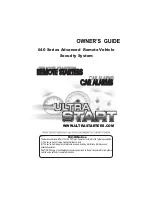
8
9
Power Up
When the unit is turned on it performs a self-test, which activates the visual alarm. If the self-test fails, or the alarm does
not activate, do not use. Failure to do so may adversely affect product performance and
result in sickness or death.
When the detector is first powered, the status light will alternate between RED and GREEN
as the unit performs a 2-1/2 minute
warm-up cycle and self-test procedure. The buzzer on the CM-16A will cycle twice, emitting its characteristic 4-chirp tone. At
the end of this 2-1/2 minute cycle, the status light will turn GREEN to indicate normal operation and safe air. The alarm relay is
not energized during the 2-1/2 minute warm-up cycle.
Operation
The CM-16A continuously monitors the air. If the CM-16A measures levels of CO greater than the danger level, the RED light
will turn on, the Alarm Relay will switch to actuate the alarm circuits in the control panel, and the buzzer on CM-16A units will
sound. The computer in the CM-16A is programmed to alarm if the danger levels of carbon monoxide are exceeded, which are
time and concentration related. When the detector is first powered, the status light will alternate between RED and GREEN as
the unit performs a 2-1/2 minute warm-up cycle and self-test procedure. At the end of this 2-1/2 minute cycle, the status light
will turn GREEN to indicate normal operation and safe air. The alarm relay is not energized during the 2-1/2 minute
warm-up cycle.
Individuals with certain medical problems may consider using warning devices that provide audible and visual signals for
carbon monoxide concentrations below 30 ppm.
ALARMS
The alarm points are: 70 ppm of CO after 60 to 240 minutes, 150 ppm of CO after 10 to 50 minutes, and 400 ppm of CO
after 4 to 15 minutes, in accordance with the provisions of UL Standard 2034. This product is not UL listed. The CM-16A will
automatically come out of alarm once the air clears. The time to stop alarming will depend on the CO exposure time and the
CO level.
Immediately exit the environment if it causes an alarm condition on the detector.
Failure to do so may result in sickness
or death.
The following symptoms are related to CARBON MONOXIDE POISONING and should be discussed with ALL
members of the household:
- Mild exposure: Slight headache, nausea, vomiting, fatigue (often described as “Flu-like” symptoms).
- Medium Exposure: Severe throbbing headache, drowsiness, confusion, fast heart rate.
- Extreme Exposure: Unconsciousness, convulsions, cardio respiratory failure, and death.
Many cases of reported CARBON MONOXIDE POISONING indicate that while victims are aware they are not well, they
become so disoriented they are unable to save themselves by either exiting the building or calling for assistance. Young
children and household pets may be the first affected.
Transient CO situations can occur:
1. Excessive spillage or reverse venting of fuel burning appliances caused by outdoor ambient conditions, such as:
a) Wind direction and/or velocity, including high gusts of wind. Heavy air in the vent pipes (cold/humid air with
extended periods between cycles).
b) Negative pressure differential resulting from the use of exhaust fans.
c) Simultaneous operation of several fuel-burning appliances competing for limited internal air.
d) Vent pipe connections vibrating loose from clothes dryers, furnaces, or water heaters.
e) Obstruction or unconventional vent pipe designs, which can amplify the above situations.
2. Extended operation of un-vented fuel burning devices (range, oven, fireplace, etc.).
3. Temperature inversions, which can trap, exhaust gases near the ground.
4. Car idling in an open or closed attached garage, or near a home.
RESET/SILENCE SWITCH
The switch on the front of the CM-16A labeled “TEST/RESET,” performs three functions.
1. A short press of switch, less than 5 seconds, will place the unit into self test mode with no alarm relay activation. The
status light will turn red for 5 seconds and then it will alternate slowly between green and amber while the self-test
executes. The controlling software simulates a 3000 ppm CO environment and causes the unit to alarm after approximately
one minute has elapsed. When this happens, the status light turns red for five seconds. The unit will then return to normal
operation.
2. A long press of switch, 5 or more seconds long, will place the unit into self-test mode with alarm relay activation. Pressing
and holding the switch will cause the status light to turn red for 5 seconds and then switch to solid amber. The alarm relay
will then be activated and the switch can be released. After about 5 seconds, the alarm relay will turn off and the status
light will alternate slowly between green and amber while the self test executes. The controlling software simulates a 3000
ppm CO environment and causes the unit to alarm after approximately one minute has elapsed. When this happens, the
status light turns red for five seconds. The unit will then return to normal operation.
3. If the CM-16A is in an alarm condition due to the detection of carbon monoxide, one push of the switch will cause the
alarm relay to open for five minutes. After the five-minute period, if CO is still present, the status light will again switch to
RED, the alarm relay will close. If after the five-minute period, the detected CO level has dropped below 70 ppm, the
CM-16A unit will reset.
W
WARNING
W
WARNING
W
WARNING
W
WARNING
























